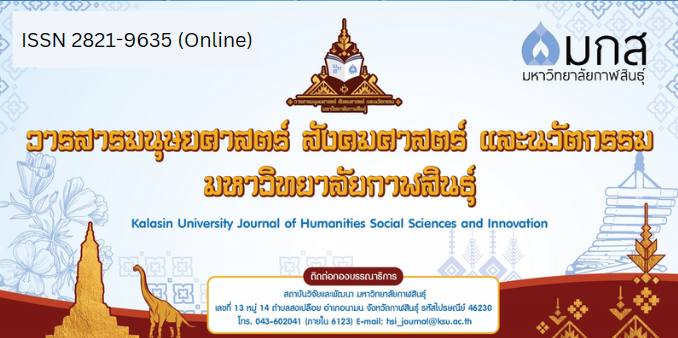Communication Challenges in Implementing Anti-Bullying Policies in East Java’s Capital Agglomeration City
Main Article Content
บทคัดย่อ
This research consists of two main purposes: 1) to examine stakeholder interactions, power dynamics, and communication strategies in the implementation of anti-bullying policies in Sidoarjo Regency, East Java, 2) to identify gaps in the current communication and governance frameworks and provide actionable recommendations to strengthen the implementation process and enhance the effectiveness of anti-bullying initiatives. Using qualitative methods and thematic analysis, data were gathered from 22 respondents, including school principals, teachers, and NGO representatives involved in the initiative. Semi-structured interviews and document analysis were used as primary tools for data collection. The results of the research were found: 1) Stakeholder interactions in Sidoarjo’s anti-bullying policy implementation are characterized by informal coordination, limited trust, and communication dominated by top-down directives. Intermediary actors like INOVASI and UMSIDA bridge national and local levels, but feedback mechanisms remain weak. 2) The research identified gaps such as unclear role distribution, sectoral egos, digital disparities, and culturally mismatched messaging. Recommendations include establishing a district-level coordination task force, integrating ICT tools, engaging religious leaders, and developing culturally sensitive, localized communication strategies with structured, inclusive feedback loops for adaptive governance. Based on these findings, the study recommends strengthening formal communication channels, encouraging inclusive participation from all stakeholders, expanding digital infrastructure in rural areas, and applying culturally responsive communication strategies. In addition, regular professional development for teachers and improved inter-agency coordination are essential to support more effective and sustainable anti-bullying efforts in Sidoarjo Regency.
Downloads
Article Details

อนุญาตภายใต้เงื่อนไข Creative Commons Attribution-NonCommercial-NoDerivatives 4.0 International License.
ข้อมูลภาพ เสียง วิดีโอ และข้อความที่ปรากฎบนเว็บไซต์นี้ ผู้นำไปใช้จะถูกอนุญาตให้นำไปใช้ได้ โดยจะต้องอ้างอิงแหล่งที่มา จะต้องไม่นำไปใช้เพื่อการค้า และจะต้องไม่ดัดแปลง (CC-BY-NC-ND)
เอกสารอ้างอิง
Aidi, A., Avianti, I., Koeswayo, P. S., Poulus, S., & Mariam, S. (2024). The effect of an inclusive approach to collaborative governance and its impact on digitizing the quality of public services. Cogent Business & Management, 11(1). https://doi.org/10.1080/23311975.2024.2392324
Ansell, C., & Gash, A. (2020). Collaborative governance in theory and practice. Journal of Public Administration Research and Theory, 30(3), 453–475. https://doi.org/10.1093/jopart/mum032
Bali, A. S. (2021). Navigating complexity in policy implementation. In H. Sullivan, H. Dickinson, & H. Henderson (Eds.), The Palgrave handbook of the public servant (pp. 1–17). Palgrave Macmillan, Cham. https://doi.org/10.1007/978-3-030-29980-4_28
Braun, V., & Clarke, V. (2013). Successful qualitative research: A practical guide for beginners. Sage Publications.
Creswell, J. W. (2007). Qualitative inquiry and research design: Choosing among five approaches (2nd ed.). Sage Publications.
Emerson, K., Nabatchi, T., & Balogh, S. (2012). An integrative framework for collaborative governance. Journal of Public Administration Research and Theory, 22(1), 1–29. 1 https://doi.org/10.1093/jopart/mur011
Fang, C., & Yu, D. (2017). Urban agglomeration: An evolving concept of an emerging phenomenon. Land Use Policy, 66, 293–301. https://doi.org/10.1016/j.landurbplan.2017.02.014
Gabnyte, G., & Strakšiene, D. (2019). The role of communication and collaboration influencing teachers’ professional motivation. Social Welfare: Interdisciplinary Approach, 9(2), 67-77. https://doi.org/10.21277/sw.v2i9.474
Howlett, M., & Tosun, J., (2021). The Routledge handbook of policy styles. Routledge International Handbooks. Routledge.
Klijn, E. H., & Koppenjan, J. F. M. (2020). Governance networks in the public sector. Routledge.
Koppell, J. G. S. (2010). Administration without borders. Public Administration Review, 70(6), 933–941. https://doi.org/10.1111/j.1540-6210.2010.02245.x
Lohr, S. L. (2021). Sampling: Design and analysis (3rd ed.). Chapman and Hall/CRC. https://doi.org/10.1201/9780429298899
Meek, J. W., & Thurmaier, K. (Eds.) (2012). Networked governance: The future of intergovernmental management. CQ Press.
https://doi.org/10.4135/9781483349473
Miles, M. B., & Huberman, A. M. (1994). Qualitative data analysis: An expanded sourcebook (2nd ed.). Sage Publications.
Nandkeolyar, S. (2025, February 4). Relation of public opinion with public policy. SSRN. http://dx.doi.org/10.2139/ssrn.5127775
National Center for Education Statistics NCES. (2025). Program for International Student Assessment (PISA).
https://nces.ed.gov/surveys/pisa/pisa2018/
Pološk, Vokić, N., Rimac Bilušić, M., & Najjar, D. (2021). Building organizational trust through internal communication. Corporate Communications: An International Journal, 26(1), 70-83.
https://doi.org/10.1108/CCIJ-01-2020-0023
Sahal, S. (2023). Report on child violence in Sidoarjo elementary schools. Women’s Empowerment, Child Protection, and Family Planning Office.
Subroto, A. (2012). Understanding complexities in public policy making process through policy cycle model: A system dynamics approach (Universitas Indonesia, Graduate School of Management Research Paper No. 13-07).
http://dx.doi.org/10.2139/ssrn.1992756
Walter, M. (2010). Social research methods: An Australian perspective. Oxford University Press.
Yin, R. K. (2016). Qualitative research from start to finish. Guilford Publications.


